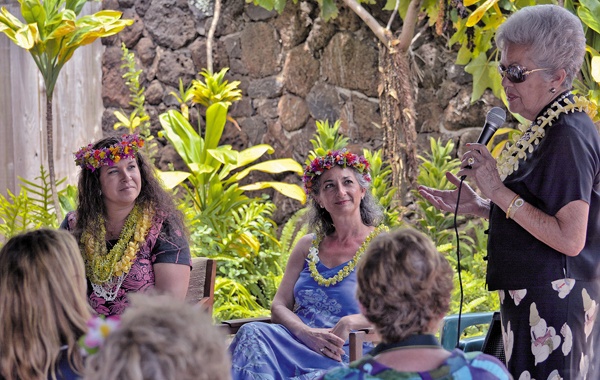When Leinaala Pavao Jardin’s students dance hula to the melody of Hawaiian music compositions, their swift hand and foot movements allow them to glide across almost any stage they walk on. But behind hula’s artistry, the Kalaheo kumu hula says,
When Leinaala Pavao Jardin’s students dance hula to the melody of Hawaiian music compositions, their swift hand and foot movements allow them to glide across almost any stage they walk on.
But behind hula’s artistry, the Kalaheo kumu hula says, tells a visual story — verse by verse — about the history and mythology of the islands.
During her nearly two-hour talk story session Saturday at Kauai Museum and a hula performance by her students from the Ka Lei Mokihana o Leina‘ala, Jardin shared her insights as she spoke about her journey into performing and now teaching hula.
“When you deliver a hula, when you do a performance, it’s not just about the dance — it encompasses so many things,” Jardin said as she spoke about preparing for her first Merrie Monarch performance under the direction of late Hilo kumu hula Rae Fonseca.
Part of this process, she explained, is keeping a song’s composer in mind and transporting audience members on a journey to a special time and place.
Jardin said it is a process that she tries to share with her students before each performance by introducing them to a song’s composer and taking them to the places described in each song.
“It really doesn’t come down to skill,” Jardin explains. “What is really comes down to is love and what you do with it.”
One of her students, 10-year-old Luke Hunadi, explained how he will — over the next week — take a helicopter flight around the island, hike to Hanakapiai, and meet with local kumu hula Shane Kamakaokalani “Maka” Herrod in Kealia just as Waipuna composer Kale Hannahs had done about a year ago when he composed the song “Nui Ke Aloha No Kauai.”
“The song talks about laughing and having fun on Kauai,” said Hunadi, who will dance to the song in July for a competition. “It gives me a feeling of how that helicopter ride was and the hike and how they sat down with Uncle Maka and laughed.”
What is also important, Jardin said, is remembering how special the art of hula and honoring the art with each performance — a mantra that Fonseca, her kumu hula, engrained in all of his students.
“Our hula was something that was taken away from our Hawaiian people for a long time,” Jardin said. “Our kupuna hid underground in a sense and danced just to keep it alive in their own special way, so for my kumu, the hula means so much, and if you’re going to do it, do your best to do it right.”
Pamela Varma Brown, the talk story facilitator and “Kauai Stories” author, said the success of Jardin’s halau, which has been marked in recent years by regular appearances at the Queen Liliuokalani Keiki Hula and Merrie Monarch competitions, is evident through her love of hula and dedication to the art.
“After listening to Leinaala you know where it all starts — it starts in her heart and in her students’ hearts,” Brown said.


